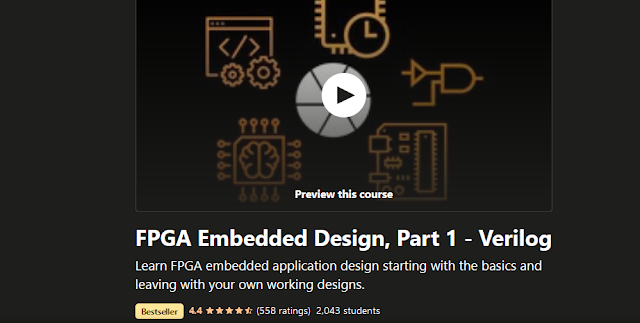FPGA Embedded Design, Part 1 - Verilog
Learn FPGA embedded application design starting with the basics and leaving with your own working designs.
Start now FPGA Embedded Design, Part 1 - Verilog
What you'll learn
- Design hardware behavior with the Verilog Hardware Description Language
- Simulate Verilog Modules.
- The FPGA Embedded Design curriculum will take you by the hand through learning Verilog, how to simulate your designs, how to make them real in an FPGA, and finally how to design and use your own Soft Processor. This will take place in a series of courses. This first course is about the Verilog Hardware Description Language.
- This is NOT a System Verilog course. However, learning Verilog is a starting point if you want to learn System Verilog (Similar to learning C prior to C++).
Requirements
- Basic programming knowledge sometimes helps, but the case of no programming experience can be an advantage since you will learn something other than traditional sequential programming.
- Although a refresher is provided in this course, some basic digital electronics knowledge always helps. Not necessarily advanced stuff, just the basics: Logic gates, maybe flip flops, counters, tristate buffers, etc.
- Ultimately, an FPGA development board will come in handy to build and test your projects. We'll use it starting at the second course in the series.
Description
Do you feel you've learned enough about microcontrollers? Do you want to learn more embedded application design techniques? How about a technique that will allow you to design high-performance systems the way professional equipment designers do?
If you're still interested, this curriculum is for you. The FPGA Embedded Design series will teach you the exquisite art of FPGA design.
So what is an FPGA anyway?
Before moving on, let me tell you that an FPGA is not a microcontroller. It's not a computer. Well, at least not if you don't want it to be a microcontroller or computer.
The simplest explanation of an FPGA I've found is that it's a shape shifter! It's an integrated circuit that will behave as the logic circuit you'd like, and the way of letting it know the desired behavior is, yes, you guessed it, through programming.
But you will not do this with a Programming Language, but with a Hardware Description Language!
In this course, you'll learn Verilog, which is one of the most widely used Hardware Description Languages (along with VHDL). You'll learn the concurrent paradigm in the Verilog code and how to design digital systems with this powerful language. You'll also learn that there are many purposes of an HDL: System design, simulation, implementation in either a traditional chip, or the popular FPGA alternative.
Don't let this opportunity pass. Take the first step into the other side of embedded systems: FPGA Embedded Design.
Who this course is for:
- Anyone who wants to learn FPGA design.
- Arduino Makers who want to take the next step into embedded systems.
- Hardware engineers who would like to learn about the exciting field of FPGA design
- This course is not for experienced embedded engineers specialized in FPGAs.







0 Comments:
Post a Comment